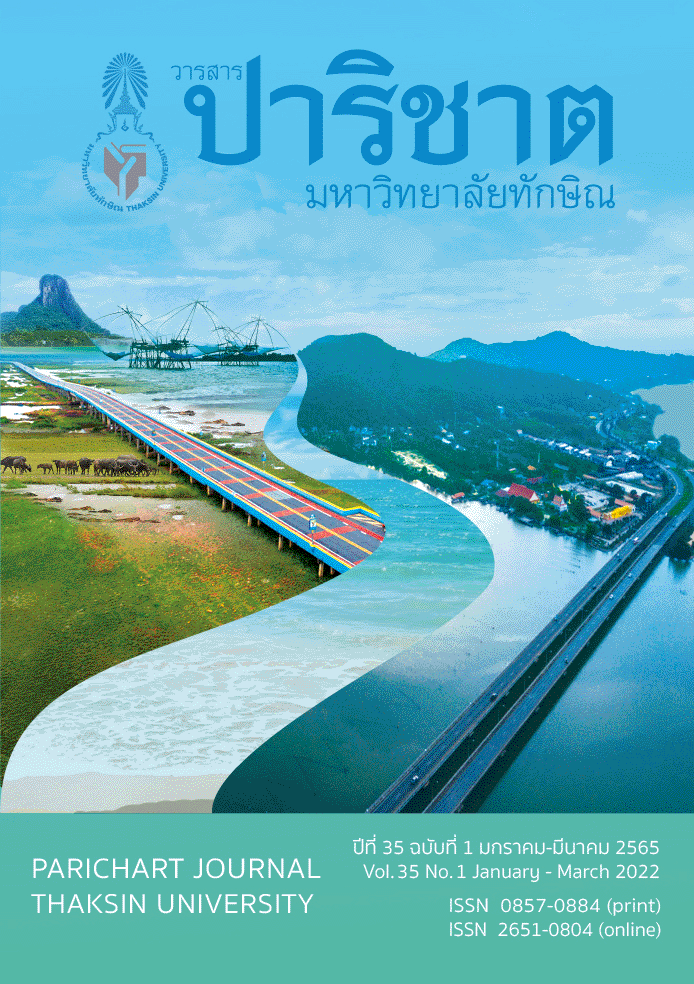The ผ้าสะระบั่นกับการให้ความหมายที่เปลี่ยนแปลงไปจากอดีตสู่ปัจจุบัน
Main Article Content
บทคัดย่อ
ผ้าสะระบั่นหรือผ้าโพกศีรษะเป็นองค์ประกอบหนึ่งของเครื่องแต่งกายของผู้ชายมุสลิม ซึ่งการให้ความหมายต่อผ้าสะระบั่นมิได้หมายถึงเครื่องแต่งกายที่นำมาประดับร่างกายให้เกิดความสวยงามเท่านั้น แต่ผ้าสะระบั่นยังถูกให้ความหมายที่แตกต่างกันออกไปในแต่ละช่วงเวลา บทความนี้มีจุดมุ่งหมายศึกษาการให้ความหมายต่อผ้าสะระบ่ั่นของผู้ชายมุสลิมไทยในอดีตและการให้ความหมายที่เปลี่ยนแปลงไปในปัจจุบันผลจากการศึกษาพบว่า ในอดีตผู้ชายมุสลิมไทยได้ให้ความหมายต่อผ้าสะระบั่นในฐานะสัญลักษณ์ของผู้ที่ผ่านการประกอบพิธีฮัจญ์ มาแล้ว เป็นสัญลักษณ์ของผู้ที่่มีความรู้และผู้นำทางด้านศาสนา แต่ภายหลังจากที่ชมรมคนรักผ้าสะระบั่นก่อตั้งขึ้นใน พ.ศ. 2557 การให้ความหมายของผ้าสะระบั่นก็เปลี่ยนแปลงไป โดยผ้าสะระบั่นถููกให้ความหมายในฐานะซุุนนะห์ของท่นนบีมูฮำหมัด (ซ.ล.) เป็นสัญลักษณ์ของผู้ที่มีเกียรติ และเป็นสัญลักษณ์ของความเป็นชายมุสลิม จากการให้ความหมายที่เปลี่ยนแปลงไปดังกล่าวส่งผลให้ผู้ชายมุสลิมไทย โดยเฉพาะในเขตภาคกลางหันมานิยมโพกผ้าสะระบั่นกันมากยิ่งขึ้น
Article Details

อนุญาตภายใต้เงื่อนไข Creative Commons Attribution-NonCommercial-NoDerivatives 4.0 International License.
เอกสารอ้างอิง
Rapipat, A. (2008). Culture is Meaning: Theory and Method of Clifford Geertz. Bangkok:
Princess Maha Chakri Sirindhorn Anthropology Center. (In Thai)
Phadung-Chevit, J, (J). (2007). Culture, Communication, and Identity. Bangkok: Active Print. (In Thai)
Jalayanateja, P. (1996). Muslim in Thailand (2nd edition). Bangkok: Central Islamic Library Project. (In Thai)
Maluneem, J. (1996). Thailand and the Muslim World: Study Only in the Case of Thai
Muslims. Bangkok: Institute of Asian Studies, Chulalongkorn University. (In Thai)
Chaisingkananont, S. (2001). Taste as a Language in Thai Consumer Culture. Bangkok:
Social Research Institute, Chulalongkorn University. (In Thai)
Gohil, N. S., & Sidhu, D. S. (2008). The Sikh Turban: Post-911 Challenges to This Article of
Faith. Rutgers Journal of low and Religion, 9(2), 1-60.
Madroh, M. (2008). The Influences of Arab Culture on Malay Society in Pattani Province.
Master’s Thesis. Songkla: Prince of Songkla University. (In Thai)
Trust, A. K. (2009). Preserving Turban as The Glorious Heritage. India: Society publication
Takim, L. (2018). Black or white: The Turbanization of Islam. Master’s thesis. Hamilton:
McMaster University.
Hidayatullael, F. (2018). The Hadith Understanding about the Use of the Turban according to Dr. Ahmad Luthfi Fathullah, Ma, the Study Program of the Al-Qur’an Science
and Tafsir, Faculty of Ushuluddin. Master’s thesis. Jakarta: Islam Negeri Syarif
Hidayatullah University.
Ghazzawi, I. A., & Sharma, T. (2017). A Turban and a Kirpan: A Turban and a Kirpan: The Story of a Sikh in America. Master’s thesis. University of La Verne and University of
Southern California.
Ismail, S. M., & Marzidin, A. A. (2017). The Wearing of Turbans among Muslims and Sikh Followers in Malaysia: Is There Discrimination?. Kanun, 290-312.
Najiyah, S. F. (2019). History of the Head Cover in Indonesia: Study of Significance
Transform of the Black Cap (1908-1949). Master’s thesis. Surabaya: Islam Negeri
Sunan Ampel University.
Dolohman, A. (Interviewee), Rurak, S. (Interviewer), Address: No.71/4, Moo 6, Pakphoon District, Mueang County, Nakhon Si Thammarat Province. March 6, 2019. (In Thai)
Bangtafa. (Interviewee), Rurak, S. (Interviewer), Address: No.71/4, Moo 6, Pakphoon District, Mueang County, Nakhon Si Thammarat Province. February 21, 2020. (In Thai)
Banglee. (Interviewee), Rurak, S. (Interviewer), Address: No.71/4, Moo 6, Pakphoon District, Mueang County, Nakhon Si Thammarat Province. February 14, 2020. (In Thai)
Idris. (Interviewee), Rurak, S. (Interviewer), Address: No.71/4, Moo 6, Pakphoon District, Mueang County, Nakhon Si Thammarat Province. February 13, 2020. (In Thai)
Angeles, V. SM. (2009). 12 Constructing Identity: Visual Expressions of Islam in the
Predominantly Catholic Philippines. In E. Kolig, V. SM. Angeles and S. Wong (Eds.),
Identity in Crossroad Civilisations: Ethnicity, Nationalism and Globalism in Asia. 195-218. Amsterdam: Amsterdam University Press.
Mustafa. (Interviewee), Rurak, S. (Interviewer), Address: No.71/4, Moo 6, Pakphoon District, Mueang County, Nakhon Si Thammarat Province. February 12, 2020. (In Thai)


